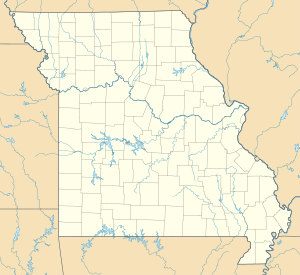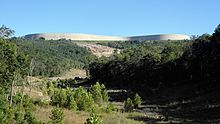Taum Sauk pumped storage power plant
| Taum Sauk pumped storage power plant | |||||
|---|---|---|---|---|---|
| The new upper basin of the dam under construction, November 2009 | |||||
|
|||||
|
|
|||||
| Coordinates | 37 ° 31 '14 " N , 90 ° 50' 4" W | ||||
| Data on the structure | |||||
| Construction time: | 1964 | ||||
| Height of the structure crown: | 486.76 m | ||||
| Data on the reservoir | |||||
| Altitude (at congestion destination ) | 484.33 m | ||||
| Storage space | 6th 800 000 m³ | ||||
| Data | |
|---|---|
| Power plant output (turbine operation): | 408 MW |
| Power plant output (pump operation): | 406 MW |
| Expansion water volume : | 158 m³ / s |
| Max. Height of fall: | 244 m |
The Taum Sauk pumped storage power plant is located in the St. Francois Mountains , part of the Ozarks in southeast Missouri , approximately 145 km south of St. Louis , USA. The operator of the plant is Ameren with headquarters in St. Louis.
In 2005 the upper basin broke and a tidal wave poured down into the valley, and the pumped storage plant has been in operation again since 2010.
power plant
Planning for the power plant began in 1960, and at the end of 1963 the first trial operation with two pump turbines and electrical generators with an output of 175 MW each took place. In 1999 the system was renewed and replaced, among other things, by more powerful generators with 220 MW each.
Taum Sauk is a purely pumped storage power plant with no natural inflow to the upper basin. This can only be filled with water from the lower basin, part of the Black River , by pumping . Typically, the pumping operation takes place during the night when there is an oversupply of electrical energy in the power grid. During the day at peak load times, water is drained from the upper basin in order to drive the electric generators.
The original construction of the upper basin, prior to the catastrophic collapse in December 2005, was characterized by repeated problems and leaks in operation. In the first year, the pumped storage power plant was only in operation for 6 months, the rest of the time it was out of operation due to necessary maintenance work. Leaks and cracks in the upper basin had to be repaired repeatedly. The upper basin was designed in such a way that the dam crest was approx. 60 cm above the water surface when it was fully filled. Due to material settlement in the mountain and insufficiently attached sensors, the dam crest was repeatedly flooded, with the consequence of washouts in the outer area.
bad luck
course
On December 14, 2005 at 5:13 a.m. local time (CST), the upper basin of the pumped storage plant broke.
A 12-minute tidal wave six meters high poured into the Black River , then flooded Johnson's Shut-Ins State Park and flowed into the largely empty lower basin. Most of the tidal wave was intercepted, but the dam wall of the lower basin was flooded despite the greater capacity, thereby threatening cities and communities downstream such as Lesterville or Annapolis .
The park ranger's house, Jerry Toops, in the woods, was torn from its foundations and washed away, all five family members survived. There were no other fatalities either, but a number of injuries.
Reasons for failure
The working hypothesis is that the dam crest of the basin was flooded when the routine nocturnal pumping process did not shut down, although the reservoir was full. According to the operator, the valves on the dam were positioned differently than the monitors on the dam of the Lake of the Ozarks , from where the pumped storage plant is monitored and controlled. The stations are connected to each other by a network of towers with microwave transmitters, so that no staff was present on site.
On September 27th, water had already overflowed in the same place.
reconstruction
Regulators approved Ameren's plans to rebuild the reservoir in late 2007. The new dam is made entirely of rolled concrete (RCC), as opposed to the original rock filler material. In addition to the facilities for measuring the filling level, there is a flood overflow to enable overflow and video surveillance to monitor the water level. The $ 450 million cost of rebuilding was largely covered by insurance.
On February 27, 2010, water was pumped into the newly built reservoir for the first time. Engineers observed the behavior of the new structure as the water rose and fell repeatedly. Final approval from the Federal Energy Regulatory Commission (FERC) to operate the facility was received on April 1, 2010. On April 15, the facility met the Missouri Public Service Commission's criteria for commissioning, and April 21, 2010 became the first Generating electricity again. The new dam was awarded the Award of Excellence in the Constructed Project by the United States Society on Dams .
Picture gallery
List of dam accidents
swell
- ^ A b J. David Rogers, Conor Watkins, David J. Hoffman: Overview and History of the Taum Sauk Pumped Storage Project. (PDF) Missouri University of Science and Technology, accessed July 16, 2015 .
- ↑ Archived copy ( memento of the original from July 14, 2011 in the Internet Archive ) Info: The archive link was inserted automatically and has not yet been checked. Please check the original and archive link according to the instructions and then remove this notice. AmerenUE's Taum Sauk Pumped Storage Plant Is Back Online
- ↑ http://www.hydroworld.com/index/display/article-display/5145640941/articles/hrhrw/damsandcivilstructures/general/2009/12/u_-s__society_on_dams.html US Society on Dams holds annual meeting and conference in California
- Southeast Missourian (Cape Girardeau, MO): Taum Sauk Reservoir fails
- Daily Journal (Park Hills, Missouri): Taum Sauk Dam Fails
- National Weather Service, St. Louis Office: Taum Sauk Dam Failure









